You may recall the diaper rash saga that actually cost me my sanity a few months back …
… especially when the rash turned out not to be regular diaper rash or even yeast but, rather, ECZEMA. After I had spent two weeks slathering my poor, defenseless infant in drugstore anti-fungal cream on the pediatrician’s recommendation.
Well, I’m happy to say that after testing and adjusting and tweaking several recipes in my super scientific diaper rash cream lab, we have a winner! And, in even better news, this balm has been washing out of our cloth diapers with no issues whatsoever.

To avoid all the chatter and skip straight to the recipe, scroll to the bottom!
The powers of this balm go beyond healing simple diaper rash. The balm can also help eczema, dry skin, psoriasis, and who knows what else. I know this because I made little sample jars to give as holiday gifts (for babies and adults) and, much to my surprise, the success stories started rolling in.

Now, I can’t claim that Beatrice is 100% eczema-free all the time. I use the cream preventively at every diaper change; when I see little red patches appearing anyway, I spend some extra time making sure to rub the cream thoroughly into those spots. Her skin is usually much improved by the next day or even the next diaper change. Also, ever since finding out that the rash is eczema, I am much more relaxed about it because I know that it does not mean that a horrible fungus is on the verge of colonizing her entire body.
Please note that when I mentioned my super scientific diaper rash cream lab above, I was not entirely serious. My “lab” is my kitchen, and my success stories are only anecdotal. I can’t guarantee that this recipe will work for everyone, but it sure works for us! Also, I don’t think I really have to say this, but I’m obviously not any sort of professional authority on baby-safe products, so use your own judgment before using this balm on your baby.
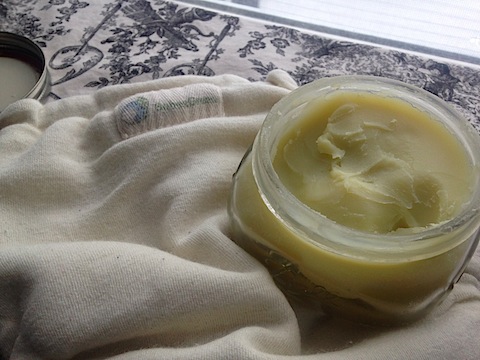
Reasoning
You may be asking why I would bother going through all these steps to make my own diaper balm when I could just embrace the convenience of using generic hydrocortisone or Aquaphor or Alba Un-Petroleum or Aveeno Baby. The OTC hydrocortisone was certainly effective when we needed to resolve the initial massive rash quickly, but it can thin the skin and cause other trouble when used over time (especially in sensitive areas), is petroleum-based (like Aquaphor), and contains a low-dose synthetic steroid hormone. I try to avoid petroleum-based products in general for these reasons, and regular use of hormones for non-critical purposes makes me nervous. The Alba Un-Petroleum helped us a great deal but would get expensive over time and create excessive waste in the form of empty tubes every week since we’d use it so much. Aveeno works for many people but contains a whole slew of “inactive ingredients” that I do not fully understand. Plus, as we have already established, I like to do things the hard way.
Cost
This balm contains many ingredients, and purchasing them all feels expensive and daunting. I am not giving you a miraculous everything-is-already-in-your-pantry recipe, but I did find everything easily on Amazon. If you have a local natural foods store, you might be able to find the ingredients there in smaller quantities before investing in, say, a full pound of beeswax. While I paid more initially to get everything I needed, the actual cost per batch is reasonable. I have calculated that an 8-11 oz. batch of my balm costs around $5.62. The same amount of Baby Aquaphor or Aveeno Baby or Un-Petroleum would cost $12 or more.
Ummmm, as an added perk, if you’re ready to dive in and buy any of these ingredients from my links below, I’ll earn enough money to take a bite of Erik’s burrito at dinner tonight :-).
Edited to add: If you prefer that I make the balm for you, please visit my Etsy shop!
Other Notes
For us, the 8-11 oz. batch of balm lasts about two weeks. I glob it on at every single diaper change and also use it to cover Bea’s rough eczema knees and cheeks. It would obviously last much longer with more sparing use. I say that the recipe makes 8-11 oz. because I usually eyeball the quantities of most of the ingredients. For example, I don’t want to waste time trying to smoosh a solid block of shea butter into a measuring cup, so I just cut a square off of the big block that looks like it might be around 1/4 cup. As a result, each batch differs somewhat in exact volume and texture. I do, however, make sure to measure the beeswax and olive oil precisely because they are the keys to the balm’s spreadable consistency.
Recipe!
Without further ado, here is the recipe for Baby Butternut Balm.
– 1/4 cup raw shea butter: Shea butter is an anti-inflammatory, healing moisturizer containing Vitamin A (Source).
– 1/4 cup organic coconut oil: Coconut oil may have anti-microbial and anti-fungal properties in addition to its moisturizing power (Source).
– 1/4 cup organic olive oil: Olive oil makes the balm spreadable in cold weather; it gets rock-hard otherwise from the shea butter and beeswax. Olive oil contains Vitamin E and oleic acid, both beneficial in skin repair (Source).
– 2 Tbsp organic beeswax pastilles: The beeswax gives the balm an ointment-esque barrier feel, so it protects and moisturizes the skin.
– 1-2 tsp evening primrose oil: I initially started using evening primrose oil (EPO) in the balm, five capsules at a time, because I had two full bottles left from when I was pregnant. I had stocked up before Bea’s birth because I was assuming I’d be pregnant past 40 weeks and would need to speed things along myself to avoid induction. She was born at 39 weeks, so I had barely made a dent in my supply of EPO. (For the same reason, I also have a lifetime supply of raspberry leaf tea taking up precious shelf space in my pantry.) I looked up the benefits of topical EPO use and found that it is a good source of Vitamin E and the essential fatty acid GLA (gamma linolenic acid), both of which are necessary for the maintenance of healthy skin and, fortuitously, may be effective at treating eczema (Source). Now that I have depleted my supply of capsules, I restocked with this bottle of EPO rather than more capsules — cheaper and more convenient.
– 7 drops organic chamomile oil: Chamomile is soothing, calming, and healing. Need I say more?
– 7 drops tea tree & lavender essential oil: Tea tree essential oil is anti-fungal, anti-septic, and especially healing for skin conditions; lavender essential oil is relaxing and cleansing.
– 2 Tbsp. – 1/4 cup tapioca starch (optional): With more starch, the balm gets creamier and less greasy, which is good for regular diaper rash; with less starch, the balm is more like a moisturizing ointment, which is better for eczema.
– 1 tsp Shea Moisture Baby Eczema Therapy (optional): I originally purchased this product when I noticed Bea’s cheeks and knees getting rough at around four months. I loved the ingredients list and was excited to try it … until I opened it and took a whiff. The smell was not terrible, but it was so overpowering that it made me nauseous. I tried applying some to Bea’s knees, and the warmth of her skin made the smell even stronger. There was no way I could put this stuff on her cheeks. Since I had already opened the tub and used some, I couldn’t return it. I did not want to toss it because I had paid $12(!!!!) for it at CVS, so it sat unused until I had the lightbulb thought to add it to the diaper balm since the ingredients could only help. I find that the scent is mild and pleasant when diluted to this degree in the balm, but it gets way too strong again if I add any more than 1 tsp. I’m still working on the first tub I bought, so I’m not sure yet if I’ll buy more when I run out.
To combine the ingredients
I use a makeshift double boiler (stainless steel bowl over a saucepan with a couple inches boiling water) to melt the four basic ingredients together, adding the beeswax last so that it does not stick to the bottom of the bowl and burn. I stir continuously until the beeswax melts, which takes a few minutes. Once the mix is liquefied completely, I stir/whisk in everything else I am using. I pour the (hot!) finished product into a wide-mouth 8 oz. glass Ball jar and transfer it to the refrigerator until it cools to solid. And voila! Rash is gone and baby mama is happy :-).
If you’ve tried the BBB, I’d love to hear how it went in the comments below!


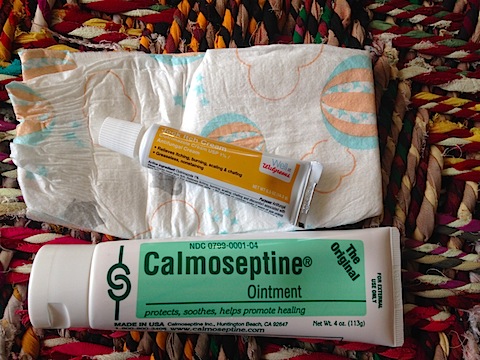
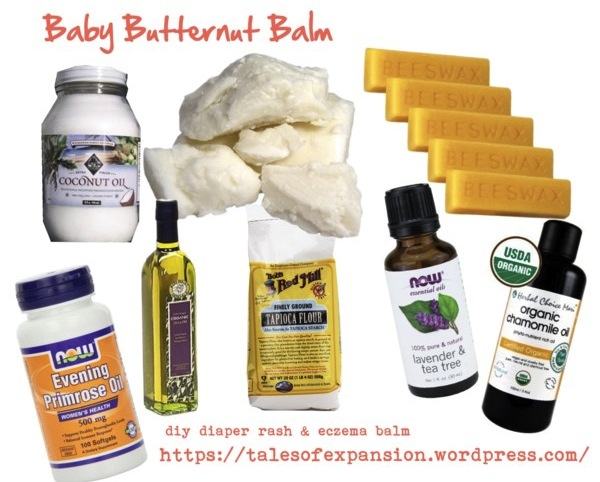
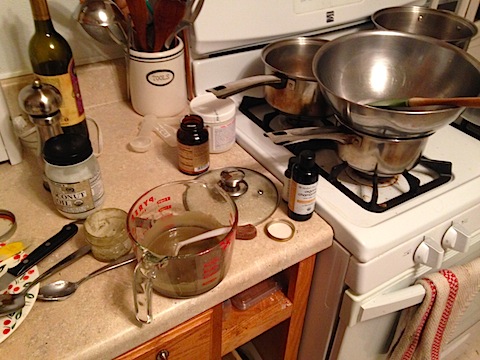
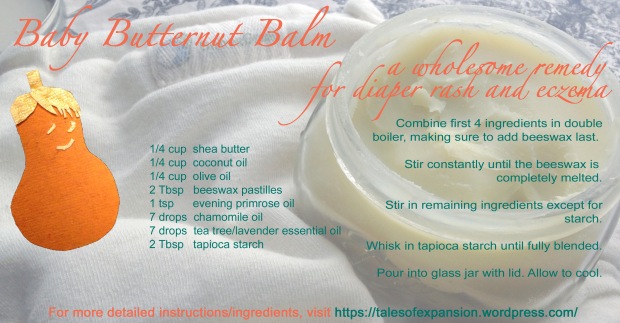
My daughter Aniyah also has really bad eczema on the back of her legs, face, hands and bum. This cream worked wonders. I put a little on her bum almost every diaper change as well as all of the other irritated areas before she goes to bed, and when she wakes up the irritated skin is no longer irritated!
LikeLike
Do you have the weight to volume conversions? Thanks
LikeLike
Is it cloth diaper safe?
LikeLike